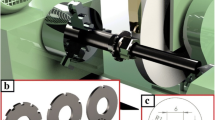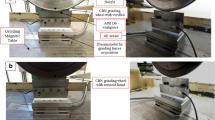Abstract
The final quality of mechanical components is directly linked to the efficiency of the machining processes to which it is subjected. In this sense, grinding can provide high standards of surface and geometric quality for mechanical components, since these characteristics are increasingly necessary for the automotive and aerospace sectors. However, the complexity of the mechanical components creates increasing difficulties for grinding. Workpieces with geometric interruptions, as in the case of gears, splined shafts, pistons, and crankshafts generate mechanical impacts and aggravate the thermal gradients during grinding, causing errors of shape, drop in surface quality and reduction in the life of the cutting tool. However, few studies on better conditions for interrupted cut grinding are seen, thus making it difficult to determine ideal grinding conditions. Thus, the present experimental investigation aims to make a comparison between cylindrical grinding of workpieces of hardened AISI 4340 steel with two, six, and twelve geometric interruptions, comparing them with the grinding workpieces without interruptions, applying white aluminum oxide wheels with vitrified and resinoid bonds. Results in terms of surface roughness, roundness deviation, acoustic emission, grinding power, diametrical wheel wear, and micrography are pointed out, indicating that the greater rigidity of the vitrified bond can be harmful during the grinding of workpieces with interrupted geometry.









Similar content being viewed by others
References
Bianchi EC, Rodriguez RL, Hildebrandt RA, Lopes JC, de Mello HJ, de Aguiar PR, da Silva RB, Jackson MJ (2019) Application of the auxiliary wheel cleaning jet in the plunge cylindrical grinding with minimum quantity lubrication technique under various flow rates. Proc Inst Mech Eng Part B J Eng Manuf 233:1144–1156. https://doi.org/10.1177/0954405418774599
Rodriguez RL, Lopes JC, Hildebrandt RA, Perez RRV, Diniz AE, de Ângelo Sanchez LE, Rodrigues AR, de Mello HJ, de Aguiar PR, Bianchi EC (2019) Evaluation of grinding process using simultaneously MQL technique and cleaning jet on grinding wheel surface. J Mater Process Technol 271:357–367. https://doi.org/10.1016/j.jmatprotec.2019.03.019
Talon AG, Lopes JC, Tavares AB, Sato BK, Rodrigues AR, Genovez MC, Dinis Pinto TA, de Mello HJ, Aguiar PR, Bianchi EC (2019) Effect of hardened steel grinding using aluminum oxide wheel under application of cutting fluid with corrosion inhibitors. Int J Adv Manuf Technol 104:1437–1448. https://doi.org/10.1007/s00170-019-04005-5
Lopes JC, Ventura CEH, de Fernandes ML, et al (2019) Application of a wheel cleaning system during grinding of alumina with minimum quantity lubrication. Int J Adv Manuf Technol 102:333–341. https://doi.org/10.1007/s00170-018-3174-4
Lopes JC, Fragoso KM, Garcia MV, Ribeiro FSF, Francelin AP, de Angelo Sanchez LE, Rodrigues AR, de Mello HJ, Aguiar PR, Bianchi EC (2019) Behavior of hardened steel grinding using MQL under cold air and MQL CBN wheel cleaning. Int J Adv Manuf Technol 105:4373–4387. https://doi.org/10.1007/s00170-019-04571-8
Sato BK, Rodriguez RL, Talon AG, Lopes JC, Mello HJ, Aguiar PR, Bianchi EC (2019) Grinding performance of AISI D6 steel using CBN wheel vitrified and resinoid bonded. Int J Adv Manuf Technol 105:2167–2182. https://doi.org/10.1007/s00170-019-04407-5
MIAO Q, DING W, KUANG W, YANG C (2020) Grinding force and surface quality in creep feed profile grinding of turbine blade root of nickel-based superalloy with microcrystalline alumina abrasive wheels. Chinese J Aeronaut. https://doi.org/10.1016/j.cja.2019.11.006
Garcia MV, Lopes JC, Diniz AE, Rodrigues AR, Volpato RS, Sanchez LEA, de Mello HJ, Aguiar PR, Bianchi EC (2020) Grinding performance of bearing steel using MQL under different dilutions and wheel cleaning for green manufacture. J Clean Prod 257:120376. https://doi.org/10.1016/j.jclepro.2020.120376
de Martini FL, Lopes JC, Volpato RS et al (2018) Comparative analysis of two CBN grinding wheels performance in nodular cast iron plunge grinding. Int J Adv Manuf Technol 98:237–249. https://doi.org/10.1007/s00170-018-2133-4
Köklü U (2013) Optimisation of machining parameters in interrupted cylindrical grinding using the Grey-based Taguchi method. Int J Comput Integr Manuf 26:696–702. https://doi.org/10.1080/0951192X.2012.749537
de Mello HJ, de Mello DR, Rodriguez RL, Lopes JC, da Silva RB, de Angelo Sanchez LE, Hildebrandt RA, Aguiar PR, Bianchi EC (2018) Contribution to cylindrical grinding of interrupted surfaces of hardened steel with medium grit wheel. Int J Adv Manuf Technol 95:4049–4057. https://doi.org/10.1007/s00170-017-1552-y
Kudryashov EA, Smirnov IM (2017) Tool guarantee of intermittent cutting processes. Manuf Technol 17:887–892
Yan Y, Xu J, Wiercigroch M (2016) Regenerative chatter in self-interrupted plunge grinding. Meccanica 51:3185–3202. https://doi.org/10.1007/s11012-016-0554-4
de Martini FL, Lopes JC, Ribeiro FSF et al (2019) Thermal model for surface grinding application. Int J Adv Manuf Technol 104:2783–2793. https://doi.org/10.1007/s00170-019-04101-6
Lopes JC, Garcia MV, Volpato RS, de Mello HJ, Ribeiro FSF, de Angelo Sanchez LE, de Oliveira Rocha K, Neto LD, Aguiar PR, Bianchi EC (2020) Application of MQL technique using TiO2 nanoparticles compared to MQL simultaneous to the grinding wheel cleaning jet. Int J Adv Manuf Technol 106:2205–2218. https://doi.org/10.1007/s00170-019-04760-5
Guo C, Chen Y (2018) Thermal modeling and optimization of interrupted grinding. CIRP Ann 67:321–324. https://doi.org/10.1016/j.cirp.2018.04.083
Bianchi EC, Rodriguez RL, Hildebrandt RA, Lopes JC, de Mello HJ, da Silva RB, de Aguiar PR (2018) Plunge cylindrical grinding with the minimum quantity lubrication coolant technique assisted with wheel cleaning system. Int J Adv Manuf Technol 95:2907–2916. https://doi.org/10.1007/s00170-017-1396-5
Bianchi EC, Sato BK, Sales AR, Lopes JC, de Mello HJ, de Angelo Sanchez LE, Diniz AE, Aguiar PR (2018) Evaluating the effect of the compressed air wheel cleaning in grinding the AISI 4340 steel with CBN and MQL with water. Int J Adv Manuf Technol 95:2855–2864. https://doi.org/10.1007/s00170-017-1433-4
Malkin S, Guo C (2008) Grinding technology: theory and applications of machining with abrasives, 2aed. Industrial Press Inc, New York
Munhoz MR, Dias LG, Breganon R, Ribeiro FSF, de Souza Gonçalves JF, Hashimoto EM, da Silva Júnior CE (2020) Analysis of the surface roughness obtained by the abrasive flow machining process using an abrasive paste with oiticica oil. Int J Adv Manuf Technol 106:5061–5070. https://doi.org/10.1007/s00170-019-04920-7
King RI, Hahn RS, Devereux OF (2009) Handbook of modern grinding technology. J Eng Mater Technol 109:353. https://doi.org/10.1115/1.3225989
de Moraes DL, Garcia MV, Lopes JC, Ribeiro FSF, de Angelo Sanchez LE, Foschini CR, de Mello HJ, Aguiar PR, Bianchi EC (2019) Performance of SAE 52100 steel grinding using MQL technique with pure and diluted oil. Int J Adv Manuf Technol 105:4211–4223. https://doi.org/10.1007/s00170-019-04582-5
Lopes JC, de Martini FL, Garcia MV et al (2020) Performance of austempered ductile iron (ADI) grinding using diluted oil in MQL combined with wheel cleaning jet and different CBN grains friability. Int J Adv Manuf Technol 107:1805–1818. https://doi.org/10.1007/s00170-020-05142-y
Lopes JC, de Martini FL, Domingues BB et al (2019) Effect of CBN grain friability in hardened steel plunge grinding. Int J Adv Manuf Technol 103:1567–1577. https://doi.org/10.1007/s00170-019-03654-w
Eshghy S (1968) Thermal aspects of the abrasive cutoff operation. Part 2—partition functions and optimum cutoff. J Eng Ind v 90:360–364
Malkin S, Guo C (2007) Thermal analysis of grinding. CIRP Ann - Manuf Technol 56:760–782. https://doi.org/10.1016/j.cirp.2007.10.005
Moia DFG, Thomazella IH, Aguiar PR, Bianchi EC, Martins CHR, Marchi M (2015) Tool condition monitoring of aluminum oxide grinding wheel in dressing operation using acoustic emission and neural networks. J Brazilian Soc Mech Sci Eng 37:627–640. https://doi.org/10.1007/s40430-014-0191-6
Alexandre FA, Lopes JC, de Martini FL et al (2020) Depth of dressing optimization in CBN wheels of different friabilities using acoustic emission (AE) technique. Int J Adv Manuf Technol 106:5225–5240. https://doi.org/10.1007/s00170-020-04994-8
Alexandre FA, Lopes WN, Lofrano Dotto FR, Ferreira FI, Aguiar PR, Bianchi EC, Lopes JC (2018) Tool condition monitoring of aluminum oxide grinding wheel using AE and fuzzy model. Int J Adv Manuf Technol 96:67–79. https://doi.org/10.1007/s00170-018-1582-0
Strömbergsson D, Marklund P, Edin E, Zeman F (2017) Acoustic emission monitoring of a mechanochemical surface finishing process. Tribol Int 112:129–136. https://doi.org/10.1016/J.TRIBOINT.2017.03.031
SHAW MC, COOKSON JO (2005) Metal cutting principles. Oxford university press, New York
Trent EM, Wright PK (2000) Heat in metal cutting. In: Metal Cutting, 4Th edn. Butterworth-Heinemann
Rowe WB Principles of modern grinding technology, 2nd edn
Zhang Y, Li C, Yang M, Jia D, Wang Y, Li B, Hou Y, Zhang N, Wu Q (2016) Experimental evaluation of cooling performance by friction coefficient and specific friction energy in nanofluid minimum quantity lubrication grinding with different types of vegetable oil. J Clean Prod 139:685–705. https://doi.org/10.1016/j.jclepro.2016.08.073
Kalita P, Malshe AP, Arun Kumar S, Yoganath VG, Gurumurthy T (2012) Study of specific energy and friction coefficient in minimum quantity lubrication grinding using oil-based nanolubricants. J Manuf Process 14:160–166. https://doi.org/10.1016/j.jmapro.2012.01.001
Javaroni RL, Lopes JC, Sato BK, Sanchez LEA, Mello HJ, Aguiar PR, Bianchi EC (2019) Minimum quantity of lubrication (MQL) as an eco-friendly alternative to the cutting fluids in advanced ceramics grinding. Int J Adv Manuf Technol 103:2809–2819. https://doi.org/10.1007/s00170-019-03697-z
Lopes JC, Garcia MV, Valentim M, Javaroni RL, Ribeiro FSF, de Angelo Sanchez LE, de Mello HJ, Aguiar PR, Bianchi EC (2019) Grinding performance using variants of the MQL technique: MQL with cooled air and MQL simultaneous to the wheel cleaning jet. Int J Adv Manuf Technol 105:4429–4442. https://doi.org/10.1007/s00170-019-04574-5
Li B, Li C, Zhang Y, Wang Y, Jia D, Yang M, Zhang N, Wu Q, Han Z, Sun K (2017) Heat transfer performance of MQL grinding with different nanofluids for Ni-based alloys using vegetable oil. J Clean Prod 154:1–11. https://doi.org/10.1016/j.jclepro.2017.03.213
Chen ZZ, Xu JH, Ding WF, Ma CY, Fu YC (2015) Grinding temperature during high-efficiency grinding Inconel 718 using porous CBN wheel with multilayer defined grain distribution. Int J Adv Manuf Technol 77:165–172. https://doi.org/10.1007/s00170-014-6403-5
Obikawa T, Takemura Y, Akiyama Y, Shinozuka J, Sasahara H (2009) Microscopic phase-dependent residual stresses in the machined surface layer of two-phase alloy. J Mater Process Technol 209:4496–4501. https://doi.org/10.1016/j.jmatprotec.2008.10.039
Panneerselvam S, Putatunda SK, Gundlach R, Boileau J (2017) Influence of intercritical austempering on the microstructure and mechanical properties of austempered ductile cast iron (ADI). Mater Sci Eng A 694:72–80. https://doi.org/10.1016/J.MSEA.2017.03.096
da Silva LR, Bianchi EC, Fusse RY, Catai RE, França TV, Aguiar PR (2007) Analysis of surface integrity for minimum quantity lubricant-MQL in grinding. Int J Mach Tools Manuf 47:412–418. https://doi.org/10.1016/j.ijmachtools.2006.03.015
Rodriguez RL, Lopes JC, Garcia MV, Tarrento GE, Rodrigues AR, de Ângelo Sanchez LE, de Mello HJ, de Aguiar PR, Bianchi EC (2020) Grinding process applied to workpieces with different geometries interrupted using CBN wheel. Int J Adv Manuf Technol 107:1265–1275. https://doi.org/10.1007/s00170-020-05122-2
Mao C, Zhou Z, Zhang J, Huang X, Gu D (2011) An experimental investigation of affected layers formed in grinding of AISI 52100 steel. Int J Adv Manuf Technol 54:515–523. https://doi.org/10.1007/s00170-010-2965-z
Umbrello D (2013) Analysis of the white layers formed during machining of hardened AISI 52100 steel under dry and cryogenic cooling conditions. Int J Adv Manuf Technol 64:633–642. https://doi.org/10.1007/s00170-012-4073-8
Acknowledgments
The authors thank companies Nikkon Ferramentas de Corte Ltda—Saint Gobain Group for providing the grinding wheel and ITW Chemical Products for the donation the cutting fluids, and the authors thank everyone for the support to the research and opportunity for scientific and technological development.
Funding
The authors received financial support from the São Paulo Research Foundation (FAPESP) processes 2017/03788-9 and 2018/22661-2, CAPES (Coordination for the Improvement of Higher Level Education Personnel), and CNPq (National Council for Scientific and Technological Development).
Author information
Authors and Affiliations
Corresponding author
Ethics declarations
Conflict of interests
The authors declare that they have no conflict of interests.
Additional information
Publisher’s note
Springer Nature remains neutral with regard to jurisdictional claims in published maps and institutional affiliations.
Rights and permissions
About this article
Cite this article
Ribeiro, F.S.F., Lopes, J.C., Talon, A.G. et al. Comparative analysis between resinoid and vitrified bond grinding wheel under interrupted cutting. Int J Adv Manuf Technol 109, 75–85 (2020). https://doi.org/10.1007/s00170-020-05667-2
Received:
Accepted:
Published:
Issue Date:
DOI: https://doi.org/10.1007/s00170-020-05667-2




